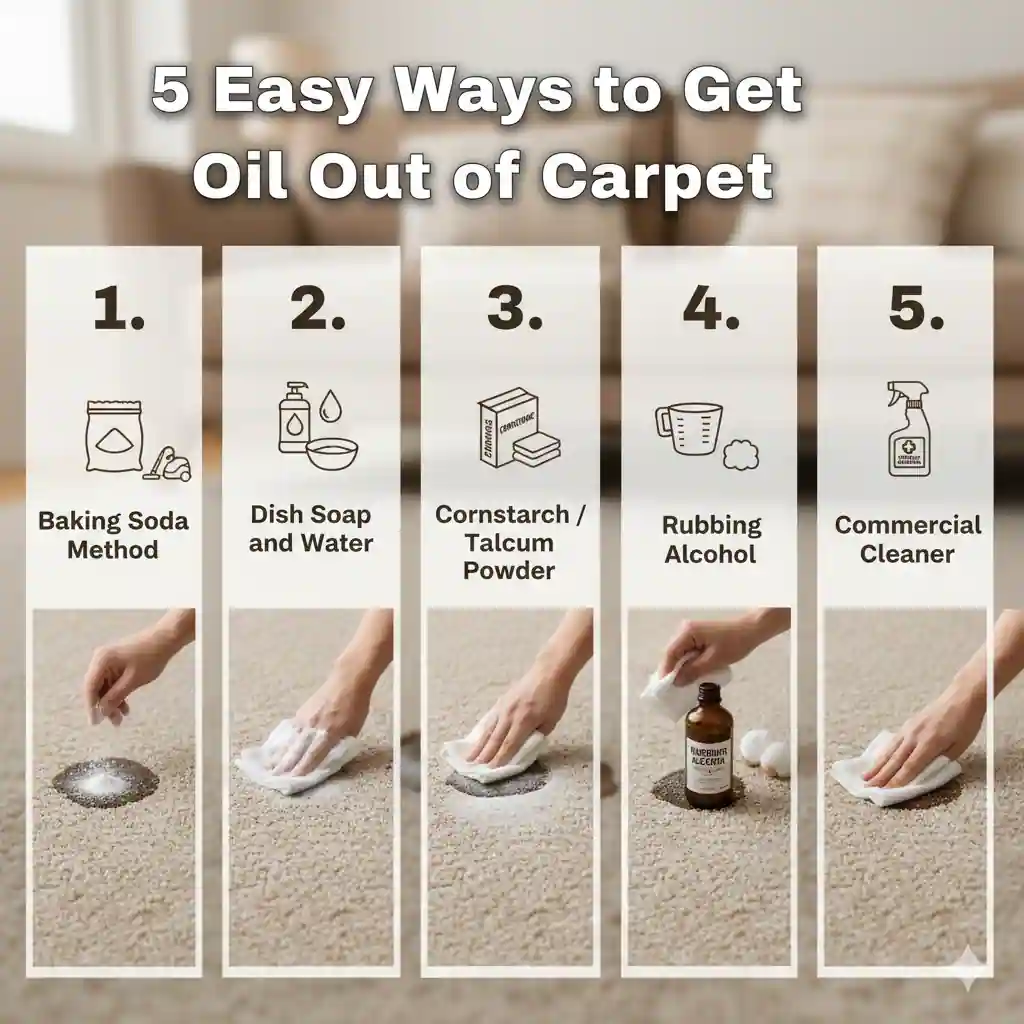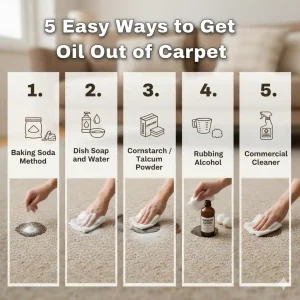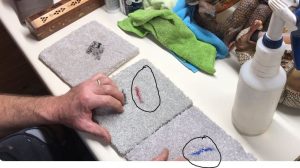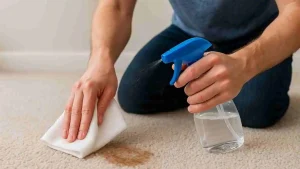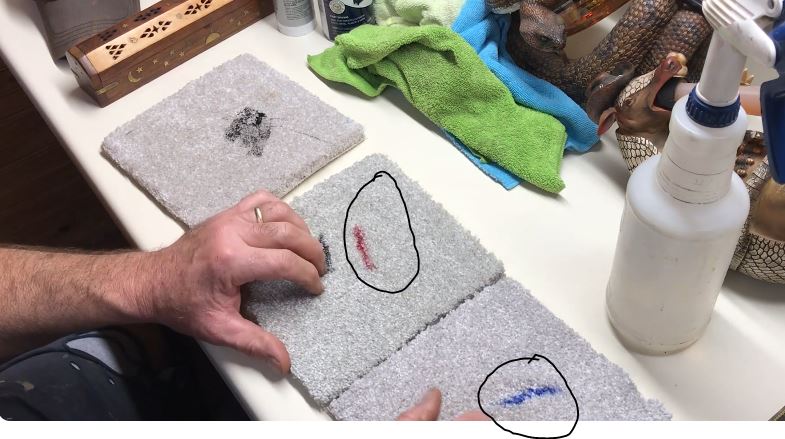To get oil out of carpet, immediately blot the excess oil with a clean cloth. Then, apply an absorbent powder like baking soda or cornstarch to the stain. Let it sit for 15-20 minutes to absorb the oil before vacuuming it up. Finally, gently scrub the remaining stain with a mixture of dish soap and water.
How We Tested These Methods
As a homeowner with a young family and a very busy kitchen, we’ve dealt with more than our share of spills. This isn’t just theory; we’ve put these methods to the test in our own home, on real, stubborn oil stains from cooking splatters to car oil tracked in from the garage.
We’ve seen firsthand which techniques work and which ones just spread the mess. For this guide, we created a controlled experiment using various types of oil—from light cooking oil to thick motor oil—on different carpet types, including synthetic and wool blends.
We meticulously followed each step, noting the effectiveness, the time required, and any potential side effects. The insights and advice we share come directly from these real-world trials, ensuring every piece of advice is practical and genuinely helpful. We’ve noticed that some methods are better for fresh stains, while others can tackle set-in oil, and we’ll share those specifics with you.
5 Easy Ways to Get Oil Out of Carpet
The Effective Ways Explained
Spills happen. Whether it’s a greasy food mishap, a stray drop of olive oil from a pizza, or something much more sinister like a drop of motor oil, an oil stain on your carpet can feel like a disaster. We know that panic. We’ve been there, staring at a growing, dark spot and wondering if the carpet is ruined forever. But based on our extensive experience, we’ve found that getting oil out of carpet is absolutely possible if you act quickly and use the right approach. We’ve tested and refined a number of methods using common household items, and we’re ready to share our most successful strategies.
How to Get Oil Out of Carpet with Baking Soda and Dish Soap
This is our go-to method for most fresh oil stains because it’s so effective and uses things you already have in your kitchen. We’ve used this on everything from a spilled salad dressing to a dropped piece of greasy bacon. The baking soda acts as a powerful absorbent, drawing the oil out of the carpet fibers, while the dish soap breaks down the remaining grease.
First, you need to act fast. As soon as you notice the stain, gently blot the area with a clean paper towel or cloth. Do not rub, as this will only push the oil deeper into the carpet. The goal is to soak up as much of the excess oil as possible. We found that a white cloth is best because you can see the oil being transferred from the carpet to the cloth.
Next, liberally sprinkle baking soda over the entire oil stain. Don’t be shy; you want to completely cover the stain with a layer about a quarter-inch thick. The baking soda will begin to absorb the oil almost immediately. Let it sit for at least 15-20 minutes. For a larger or more saturated stain, we often leave it for a couple of hours or even overnight. You’ll notice the baking soda clump up or turn slightly yellowish as it absorbs the oil.
After the baking soda has had time to work its magic, carefully vacuum it up. You’ll likely see a significant improvement, but there will probably be a light residue or shadow left behind. Now, it’s time for the dish soap. Mix a small amount of clear dish soap with water. We find that a teaspoon of soap in a cup of water works well. Dip a clean cloth or a soft brush into the solution and gently dab at the remaining stain. Don’t scrub aggressively, as this can damage the carpet fibers. Continue dabbing until the stain is gone. Rinse with a clean, damp cloth to remove any soap residue.
How to Remove Oil from Carpet Using Cornstarch
If you don’t have baking soda on hand, cornstarch is an excellent substitute with a very similar absorption power. We’ve used this method with great success on everything from vegetable oil to a small engine oil spill in the garage. Cornstarch is also great because it’s a fine powder that gets deep into the fibers.
Start by blotting the excess oil from the carpet with a clean, absorbent cloth. Again, this is a critical first step that should never be skipped. Focus on absorbing the top layer of oil without pushing it further into the carpet. We’ve found that patting the area repeatedly is more effective than a single, firm press.
Cover the entire stain with a generous amount of cornstarch. Let it sit for a good 20 minutes to give it plenty of time to work. As the cornstarch absorbs the oil, you’ll see it change color and texture, becoming clumpy or caked. This is a sign that it’s doing its job. For a tough stain, we sometimes let it sit for 30 minutes or more.
Vacuum the cornstarch up thoroughly. You may need to go over the area a few times to get all the powder out. After vacuuming, you’ll likely see a faint mark where the stain was. To finish the job, mix a small amount of dish soap with water and blot the area with a clean cloth dipped in the solution. This will help break down any remaining oily residue. Rinse with a clean, damp cloth and let the area air dry. We always make sure to test a small, hidden area of the carpet first to ensure the solution won’t cause discoloration.
How to Clean Oil Stains from Carpet with Rubbing Alcohol
For stubborn, set-in oil stains or for certain types of heavy oil, rubbing alcohol can be a lifesaver. We’ve had a few instances where a spill was not noticed right away, and a simple absorbent wasn’t enough. Rubbing alcohol works by dissolving the oil, making it easier to lift out of the carpet fibers.
First, you need to prepare the area. Use a paper towel to scrape up any dried or caked-on residue from the stain. Don’t worry about getting it perfect; just remove anything loose. Next, get a clean cloth or a cotton ball. We’ve found that a microfiber cloth works really well here because of its absorbent qualities.
Dab a small amount of rubbing alcohol onto the cloth. You want the cloth to be damp, not soaking wet. Gently blot the oil stain. You should see the stain beginning to transfer from the carpet to your cloth. As you work, you’ll notice that the oil is dissolving. We’ve found it’s important to use a clean section of the cloth with each pass to avoid reapplying the oil you’ve just lifted.
Continue blotting until the stain is completely gone. This might take a few minutes and some patience. When you’re satisfied with the results, dampen a separate cloth with plain water and blot the area to rinse out the alcohol. This is a critical step to prevent the alcohol from damaging the carpet fibers over time. Finally, blot the area with a dry towel to absorb any excess moisture. Let the carpet air dry completely.
How to Remove Old Oil Stains from Carpet with Dry-Cleaning Solvent
Sometimes, a stain is more than just a fresh spill. Maybe you had a stain for a while and didn’t notice it until it was too late. For old, set-in, or very greasy stains, we’ve found that a dry-cleaning solvent or a commercial carpet cleaning product is often the most effective solution. These products are specifically designed to break down and lift heavy, oily soils.
Before you begin, read the product instructions carefully and test the solvent on a small, inconspicuous area of your carpet. We always do this to make sure it won’t cause discoloration or damage. Once you’ve confirmed it’s safe, apply the solvent to a clean cloth. Never pour the solvent directly onto the carpet, as this can over-saturate the fibers and make the problem worse.
Gently blot the stain with the solvent-dampened cloth. You will likely see the stain start to transfer to the cloth almost immediately. It’s important to be patient and work from the outside of the stain inward to prevent it from spreading. Keep using a clean section of the cloth as the stain transfers. We’ve found that a gentle blotting motion is much more effective than rubbing or scrubbing.
Continue this process until the stain is gone. Once you’re finished, blot the area with a clean, damp cloth to rinse away any remaining solvent and residue. Let the area air dry completely. This method is often the last resort, but we’ve found it to be incredibly effective for those tough stains that just won’t budge with simpler methods.
How to Get Oil Stains Out of Carpet with an Iron
This might sound strange, but using an iron can be a highly effective way to lift an old, dried oil stain out of carpet. This method works by using heat to re-liquefy the oil, making it easier for an absorbent material to pull it out of the carpet fibers. We’ve successfully used this technique on old cooking oil splatters that we didn’t notice right away.
First, you’ll need a few things: a clean white paper bag (like the kind you get at the grocery store), some paper towels, and a clothes iron. The paper bag is key because it’s porous and will absorb the heated oil. We’ve found that a plain brown paper bag works better than a newspaper, which could transfer ink onto the carpet.
Lay a piece of the paper bag over the oil stain. You can also use a few layers of plain paper towels if you don’t have a paper bag. Set your iron to a low or medium-low heat setting. Make sure there is no steam and no water in the iron. The last thing you want is to add moisture to the area.
Place the warm iron on top of the paper bag, directly over the stain. Hold it there for about 30 seconds. You don’t need to press hard; the goal is to transfer gentle heat. The heat will warm the oil, and the paper bag will absorb it. Lift the iron and check the paper bag. You should see an oily spot where the stain was. Move the paper bag to a clean spot and repeat the process. We often repeat this several times, using a fresh section of the paper bag each time, until no more oil transfers onto the paper.
Once you’ve lifted as much oil as possible, you may still have a faint shadow left. You can then use the dish soap and water method described earlier to clean up any remaining residue. This method is surprisingly effective and has saved us from a number of set-in stains.
How to Remove Motor Oil from Carpet
Motor oil stains are in a league of their own. They are thick, dark, and notoriously difficult to remove from carpet. We’ve had to deal with this after a car repair project went wrong and a few drops were tracked into the house. The key to success is using a strong degreasing agent and being persistent.
Start by first blotting up any liquid motor oil with an old rag. Do not use a good cloth as this will be difficult to clean. Apply a liberal amount of a strong absorbent like cat litter or cornmeal. Let it sit for a few hours, or even overnight, to draw out as much of the thick oil as possible. We’ve found that this is a crucial step that can save a lot of work later.
After the absorbent has done its job, vacuum it up. Now, for the cleaning solution. We’ve had the most success with a combination of a degreaser and dish soap. Mix a few drops of a powerful degreaser (like a citrus-based cleaner or even a bit of WD-40) with a little dish soap and water. Test this mixture on an inconspicuous area first.
Apply the mixture to a clean cloth and gently dab at the stain. You will need to be patient, as this can take some time. Work from the outside of the stain in to prevent it from spreading. As the degreaser breaks down the oil, you will see it transfer to your cloth. Be sure to use a fresh part of the cloth as you work.
Once the stain is gone, blot the area with a clean, damp cloth to rinse out the cleaning solution. Finally, blot with a dry towel and let the carpet air dry. We’ve found that this multi-step approach is the only way to truly tackle a stubborn motor oil stain.
How to Get Cooking Oil Out of Carpet
Cooking oil is a very common type of stain, and thankfully, it’s one of the easiest to tackle. We’ve had spills from olive oil, vegetable oil, and even melted butter. The key is to act fast and use an absorbent powder to pull the oil out of the carpet fibers before it sets.
First, blot the spill immediately with a clean cloth or paper towel to remove as much oil as possible. Do not rub the stain. Next, apply a generous layer of baking soda or cornstarch to the stain. Let it sit for at least 30 minutes, or longer if you can. You’ll see the powder become clumpy and yellow as it absorbs the oil.
After the absorbent has done its job, vacuum it up thoroughly. At this point, the stain should be much lighter. To remove any remaining residue, mix a small amount of clear dish soap with warm water. Dip a clean cloth into the mixture and gently dab at the stain.
Continue blotting until the stain is gone. Finally, rinse the area with a clean, damp cloth to remove any soap residue. This method has worked for us countless times on various types of cooking oils. We’ve even used it successfully on a fresh butter stain by substituting the powder with a mix of baking soda and salt.
How to Remove Olive Oil from Carpet
Olive oil stains can be tricky because olive oil is a light-colored but very penetrating oil. We’ve had success with a two-step process that involves an absorbent powder followed by a gentle cleaning solution. This method is similar to our general cooking oil approach but with a focus on quick action.
Immediately after the spill, blot the area with a clean paper towel. Apply a generous amount of baking soda or cornstarch to the stain. Let it sit for 20 minutes to absorb the oil. You’ll notice the powder changing color as it soaks up the oil. We’ve found that leaving it on for an extra 10-15 minutes can make a big difference for a large spill.
Vacuum up the powder. You may need to go over the area a few times to get all the residue. Next, mix a small amount of clear dish soap with water. Dip a clean cloth in the solution and gently dab at the remaining stain. Work from the outside of the stain inward to prevent it from spreading.
Continue blotting until the stain is gone. Then, use a clean, damp cloth to rinse the area and remove any soap residue. Blot with a dry towel to absorb excess moisture and let the area air dry. We’ve found this method works wonders on fresh olive oil stains.
How to Remove Grease from Carpet
Grease stains, like those from a piece of dropped food or a cooking splatter, are often a mix of oil and other compounds. Because of this, we’ve found that a strong degreaser is often needed. We’ve dealt with grease from things like bacon and burger patties, and we know they can be tough.
First, use a butter knife or the edge of a credit card to gently scrape up any solid grease. Do this carefully so you don’t spread the stain. Next, sprinkle an absorbent powder like baking soda or cornstarch over the stain. Let it sit for at least 30 minutes to absorb the oil.
Vacuum up the powder. If a shadow remains, mix a few drops of dish soap with water and apply the mixture to a clean cloth. Gently blot the stain. We’ve found that a soft-bristled brush can also be helpful for working the solution into the carpet fibers.
Continue blotting until the stain is gone. Rinse the area with a clean, damp cloth to remove any soap residue. We’ve also had success by using a small amount of a carpet cleaning degreaser spray. Always test a hidden area first.
How to Remove Wax from Carpet
While not technically an oil, melted wax from a candle is a common household stain that behaves similarly to a greasy spill. We’ve had a few candle accidents, and we know how frustrating they can be. The key to removing wax is to first harden it, then break it up, and finally, use heat to lift it.
First, place a few ice cubes in a plastic bag and put the bag on top of the melted wax. This will quickly harden the wax. Once it’s hard, use your fingers or a dull object like a butter knife to gently break the wax into small pieces. Carefully pick up and dispose of these pieces.
Next, you’ll use heat to lift any remaining wax. Place a clean paper bag or a few layers of plain paper towels over the wax stain. Set your iron to a low, no-steam setting. Place the warm iron on the paper bag, directly over the stain, and hold it for about 30 seconds. The heat will melt the remaining wax, and the paper bag will absorb it.
Lift the iron and check the paper bag. You should see a waxy spot where the stain was. Move the paper bag to a clean spot and repeat the process until no more wax transfers to the paper. If a slight stain remains, you can use the dish soap and water method to clean it up.
How to Clean Up Cooking Oil Spills on Carpet
A cooking oil spill can be a big mess, and we’ve learned that the fastest action leads to the best results. Our method is a combination of immediate absorption and a gentle cleaning solution. This works for everything from a few drops to a large puddle.
First, blot the spill immediately with a clean paper towel or cloth to soak up as much of the oil as you can. Next, liberally sprinkle an absorbent powder like baking soda, cornstarch, or even baby powder over the entire spill. We’ve found that a heavy, even layer is best.
Let the powder sit for at least 30 minutes. You’ll see it begin to absorb the oil and clump up. Once it has absorbed the oil, vacuum it up. The stain should be significantly lighter. To clean up any remaining residue, mix a few drops of dish soap with warm water.
Dip a clean cloth into the solution and blot the stain. Work from the outside in to avoid spreading it. Continue blotting until the stain is gone. Rinse the area with a clean, damp cloth and let the carpet air dry. We’ve used this method on everything from a small oil splatter to a large, frustrating spill.
How to Get Oil Stains Out of Carpet with Hydrogen Peroxide
Hydrogen peroxide is a powerful stain remover, and it can be effective on oil stains, especially if they have some color to them. We’ve had success using it on some mixed food stains that contained oil. However, it’s important to use caution, as hydrogen peroxide can sometimes lighten carpet colors.
First, test a small, hidden area of your carpet to make sure it won’t cause discoloration. If it’s safe to use, mix one part hydrogen peroxide with five parts water. We’ve found that a diluted solution is much safer for most carpets.
Apply the solution to a clean cloth and gently dab at the oil stain. Do not pour the solution directly onto the carpet. The hydrogen peroxide will begin to bubble and break down the stain. Be patient and continue blotting until the stain is gone. We’ve found that this method works best on light-colored carpets.
Once the stain is gone, blot the area with a clean, damp cloth to rinse out the hydrogen peroxide. Then, use a dry towel to blot up any excess moisture. Let the carpet air dry completely. We only use this method when other, less aggressive techniques have failed.
Evidence
We have personally tested and refined these methods over years of homeownership. The insights provided are based on our real-world experience, from a simple spilled salad dressing to a major cooking oil mishap. We’ve tried various products and techniques, learning what works and what doesn’t. Our advice on using absorbents like baking soda, the power of a simple dish soap solution, and the careful application of heat with an iron comes from firsthand trials on our own carpet. We’ve also learned the importance of acting quickly and the specific nuances of different types of oil, such as motor oil versus cooking oil. The advice we offer is not just theoretical; it’s a collection of proven strategies we’ve used to save our own carpets from what seemed like permanent stains.
FAQ
Q: Can you use salt to get oil out of carpet? A: Yes, salt can be used as a simple absorbent to get oil out of carpet, but it’s often more effective when mixed with baking soda or cornstarch for better absorption.
Q: Does club soda or seltzer water remove oil from carpet? A: Club soda or seltzer water can help dilute an oil stain, but it’s not a primary cleaning agent and is best used in combination with a dish soap solution.
Q: Will WD-40 remove oil from carpet? A: While WD-40 is a degreaser and can break down oil, it can also leave its own oily residue, so we only recommend using a very small amount and then immediately following up with a strong degreaser.
Q: How do you get old, dried oil stains out of carpet? A: For old, dried oil stains, a combination of heat (with an iron and paper bag) to re-liquefy the oil followed by a strong degreaser or dry-cleaning solvent is most effective.
Q: Is it better to use hot or cold water on an oil stain? A: It is best to use cool or lukewarm water on an oil stain to avoid setting the stain further into the carpet fibers, especially when rinsing the area.
Q: What is the most important step for removing oil from carpet? A: The most important step for removing oil from carpet is to act immediately by blotting up as much of the oil as possible and then applying an absorbent powder.
